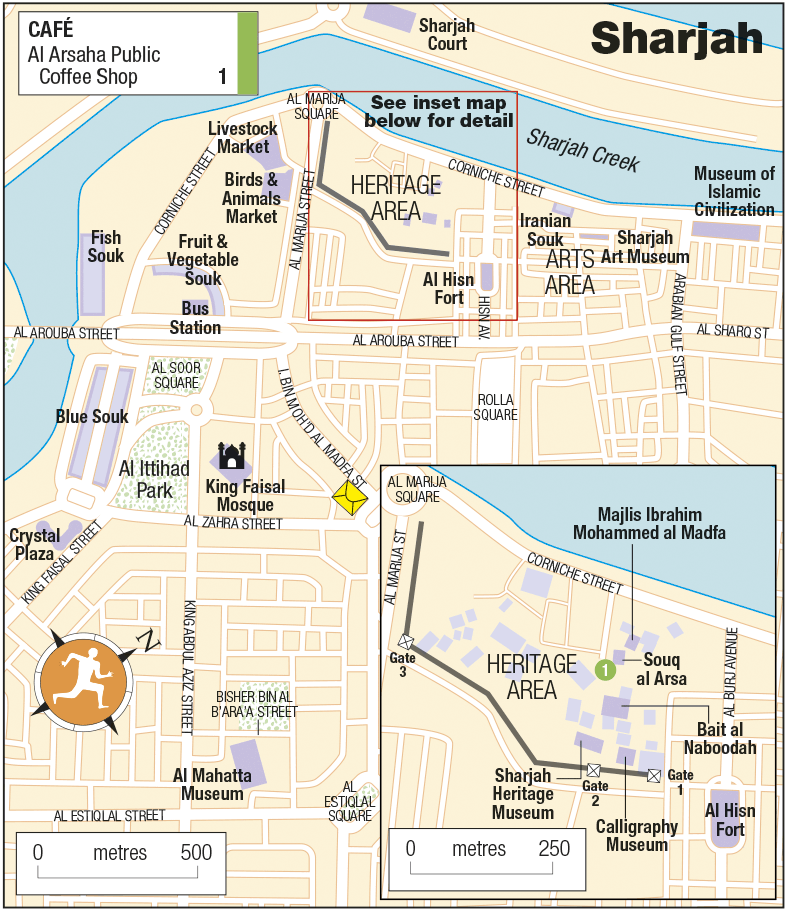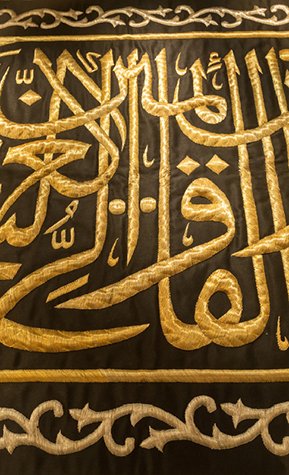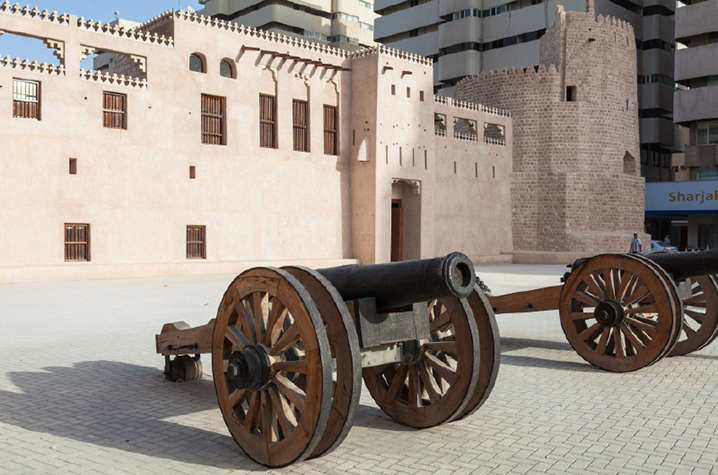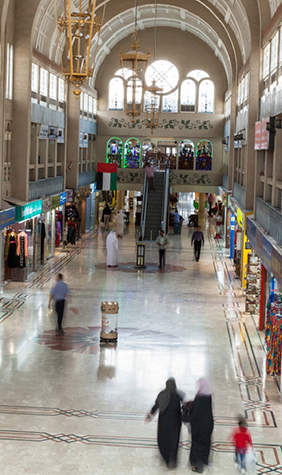Sharjah
Just 10km north up the coast, the city of Sharjah seems at first sight like simply an extension of Dubai, with whose northern suburbs it now merges seamlessly in an ugly concrete sprawl. Physically, the two cities may have virtually fused into one, but culturally they remain light years apart. Sharjah has a distinctively different flavour, having clung much more firmly to its traditional Islamic roots, exemplified by a fine array of museums devoted to various aspects of Islamic culture and local Emirati life. These include the world-class Museum of Islamic Civilization, the excellent Sharjah Art Gallery, the impressive new Sharjah Heritage Museum, and the engaging Al Mahatta aviation museum. Other attractions include the massive Blue Souk, one of the largest in the UAE, and Souq al Arsa, one of the prettiest.

Sharjah Museum of Islamic Civilization
The main reason for trekking out to Sharjah is to visit the superb Sharjah Museum of Islamic Civilization, which occupies the beautifully restored waterfront Souk al Majara building, topped with a distinctive golden dome. The museum is spread over two levels. Downstairs, the Abu Bakr Gallery of Islamic Faith has extensive displays on the elaborate rituals associated with the traditional Haj pilgrimage to Mecca, while the Ibn al Haitham Gallery of Science and Technology showcases the extensive contributions made by Arab scholars to scientific innovation over the centuries. The first floor of the museum is devoted to four galleries offering a chronological overview of Islamic arts and crafts, with superb displays of historic manuscripts, ceramics, glass, armour, woodwork, textiles and jewellery. Exhibits include the first-ever map of the then known world (ie Eurasia), created by Moroccan cartographer Al Shereef al Idrisi in 1099 – a surprisingly accurate document, although slightly baffling at first sight since it’s oriented upside down, with south at the top.

Sharjah Creek
Sharjah’s broad Creek describes a leisurely parabola around the northern edge of the city centre before terminating in the expansive Khaled Lagoon. Despite being long since eclipsed by Dubai’s various ports, Sharjah’s Creek still sees a considerable amount of commercial shipping both modern and traditional, usually with a few old-fashioned wooden dhows moored up on the far side of the water beneath a long line of spiky gantries.
Sharjah Art Museum
Occupying a large modern wind-towered building, the Sharjah Art Museum is the major showpiece in Sharjah’s attempts to position itself as a serious player in the international art scene. Temporary exhibitions of varying quality feature on the ground floor. Much more interesting is the permanent Orientalist collection upstairs, which focuses on paintings by nineteenth-century European artists depicting life in Islamic lands. Highlight is a wonderful selection of lithographs by Scottish artist David Roberts drawn from his celebrated Sketches in the Holy Land and Syria: a quintessential visual expression of Orientalism, with canvases showing picturesquely robed natives reclining among picturesque mosques, forts and assorted ruins.
Al Hisn Fort
At the heart of the city is the modest Al Hisn Fort of 1820, the most enduring symbol of old Sharjah, formerly home to the ruling Al Qassimi family, although it’s now ignominiously hemmed in by ugly apartment blocks. The fort is currently closed for extensive renovations, with no reopening date in sight.

Heritage Area
The area west of Al Hisn Fort was formerly the heart of old Sharjah, an old-fashioned quarter of traditional Emirati houses arranged around a sequence of spacious, lopsided squares and labyrinthine alleyways, and enclosed in a long section of reconstructed city wall. The entire area has now been meticulously renovated and relaunched as the city’s so-called Heritage Area, home to several interesting museums and the Souq al Arsa.
Souq al Arsa and around
The Souq al Arsa, which bounds the northern side of the Heritage Area, is far and away the prettiest in Sharjah. The souk is centred around an atmospheric central pillared courtyard, flanked by the personable little Al Arsaha Public Coffee Shop, beyond which radiates an intriguing tangle of alleyways. The coral-stone shops are stuffed full of all sorts of colourful local handicrafts as well as an eclectic selection of curios and collectibles.
Tucked away around the back (north) side of the Souq al Arsa is the attractive Majlis Ibrahim Mohammed al Madfa, topped by a diminutive round wind tower, said to be the only one in the UAE.
Bait al Naboodah
Situated in an atmospheric old house, the Bait al Naboodah offers an interesting re-creation of traditional family life in Sharjah. The main draw is the rambling two-storey building itself, one of the most attractive in the UAE, arranged around a spacious central courtyard. Only the rooms on the ground floor are open, including a string of bedrooms furnished in traditional Gulf style, with canopied wooden beds and floor cushions, the walls hung with old rifles, clocks and radios.
Sharjah Heritage Museum
The excellent new Sharjah Heritage Museum is one of the best collections of its kind anywhere in the UAE. Wide-ranging and well-explained exhibits cover all the usual bases – traditional dress, architecture, social customs, the pearling trade and so on – with many insights into lesser-known local customs en route.
The Blue Souk
The huge Blue Souk (officially known as the Central Souk) occupies an enormous, eye-catching and ungainly pair of buildings topped by myriad wind towers and clad in brilliant blue tiling. The souk is best known for its numerous carpet shops, which stock a vast range of Persian and other rugs (usually) at significantly lower prices than in Dubai.

Al Mahatta Museum
Devoted to the history of aviation in Sharjah, the Al Mahatta Museum is unexpectedly absorbing. It occupies the buildings of what was until 1977 the city’s airport, complete with aircraft hangar and air traffic control tower (the runway was incorporated into what is now King Abdul Aziz Street). The cavernous hangar contains five antique planes (plus the nose of a 1952 De Havilland Comet, the world’s first commercial jet aircraft) dating from the 1930s to the 1950s, while the remainder of the museum occupies the old airport rest house, with fascinating displays about the first commercial flights to Sharjah (launched in 1932 by Imperial Airways) and other exhibits.
Café
Al Arsaha Public Coffee Shop
This quaint little café offers a beguiling window on local life, with old photos of the UAE on the rattan-covered walls, colourful tables covered in big Lipton’s tea logos and an entertaining local clientele. It’s a good place for a glass of mint tea or a cup of coffee, and they also serve up mountainous, spicy biriyanis (chicken, mutton or fish; 20dh).